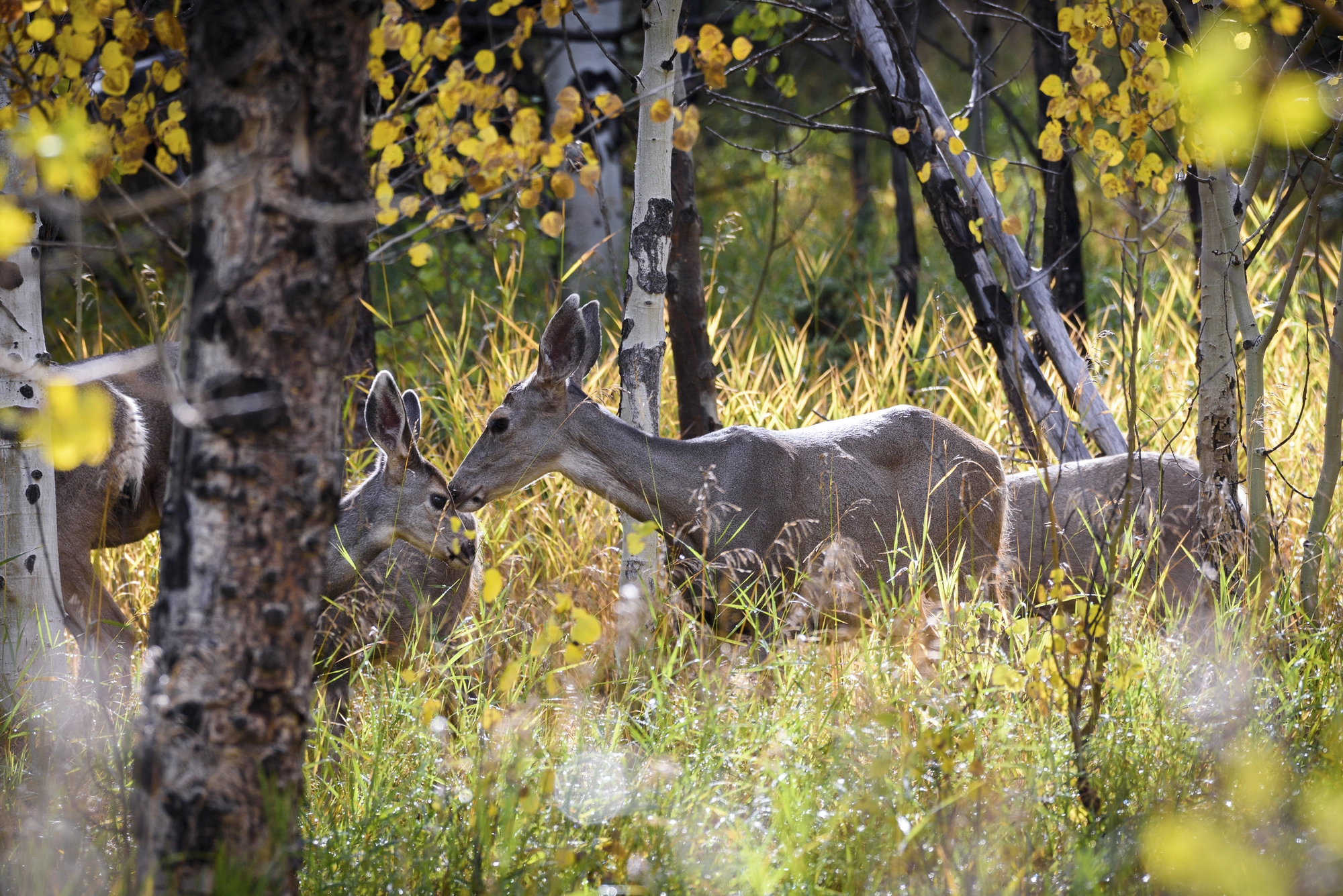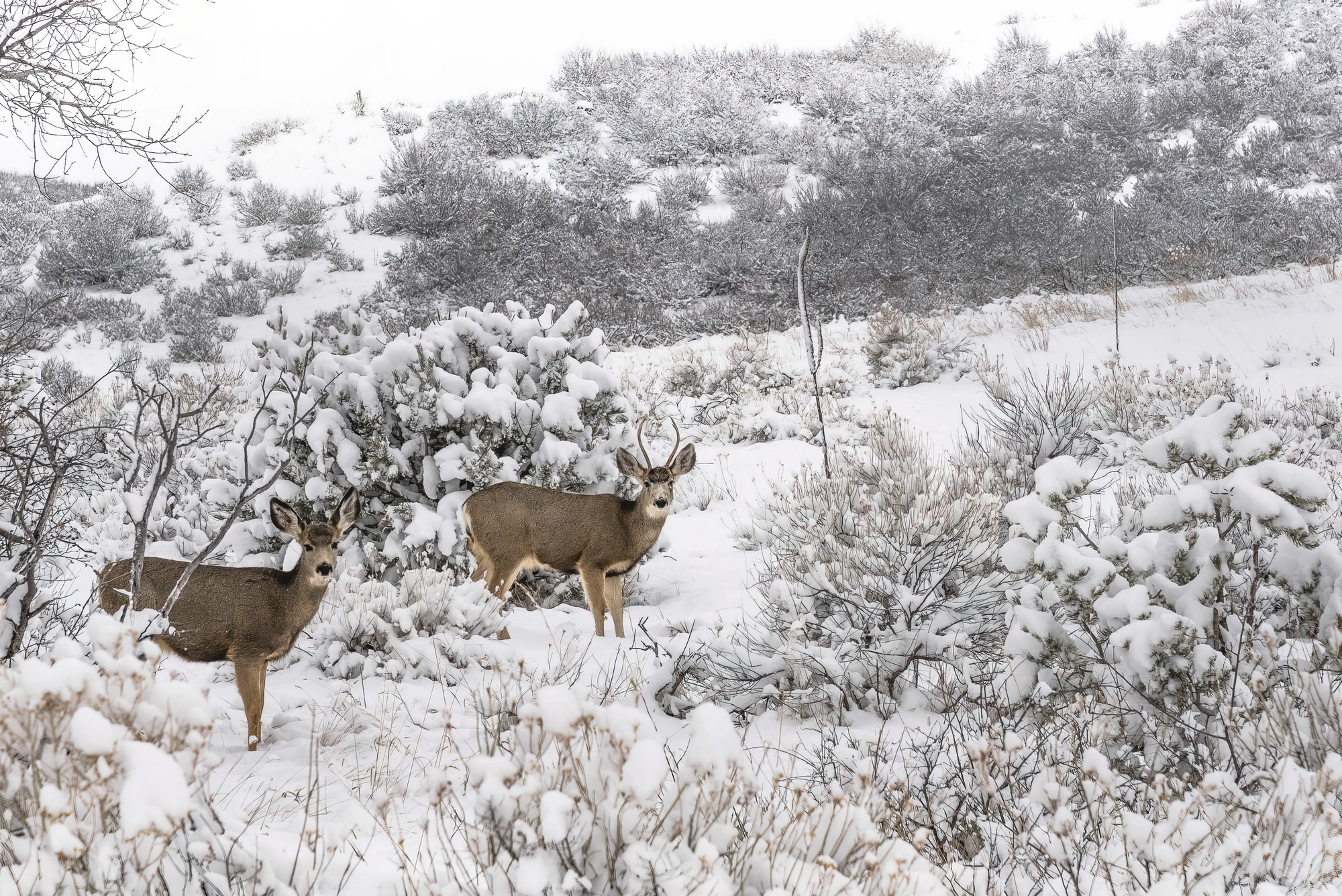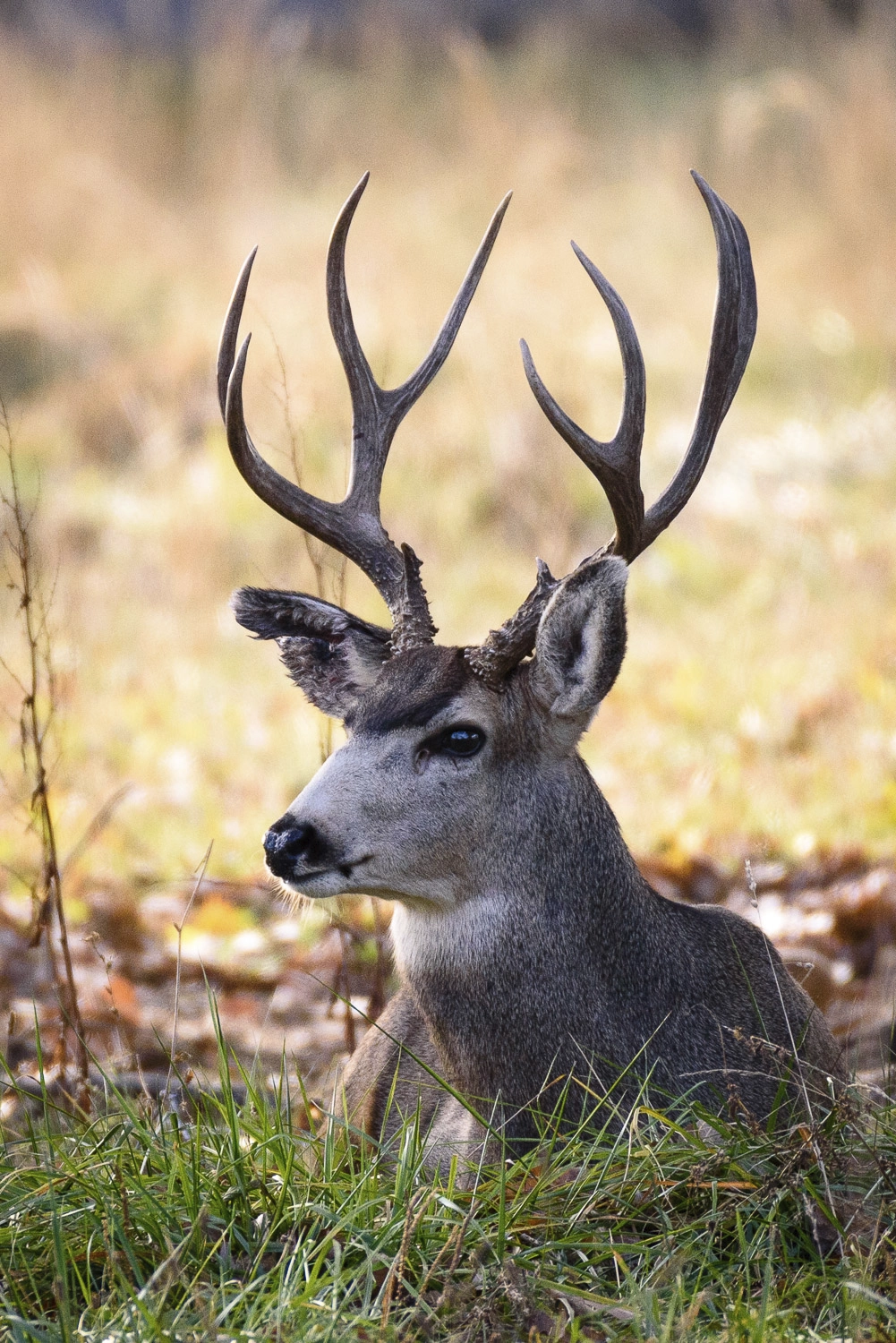You know a mule deer when you see one. Even at a distance—fog softening the ridge, wind combing the grass—the ears give them away: big, cupped dishes swiveling toward every sound. They’re built for this country of hard winters and brief, lavish summers. In the Rocky Mountains, mule deer live on a tight budget of light and heat, migrating by habit and hill slope, raising young on the edges of storms, and learning—generation after generation—how to make a living where the calendar is brutal and the scenery is magnificent.
Where They Live: A Patchwork of Elevation and Edges
“Rocky Mountain habitat” is not a single postcard. It’s a ladder of life zones stacked from sagebrush flats to alpine meadows, and mule deer use most rungs. In winter, they drop to sun-warmed, south-facing slopes where snow burns off faster and shrubs poke through: foothill grasslands, sagebrush benches, bitterbrush and mountain mahogany hillsides, and open pinyon–juniper woodlands. These places are windy and brown when the peaks are locked in white, but to a mule deer they’re a pantry of twigs and buds within reach.
Spring pushes them upslope. As snowlines retreat, green-up moves like a slow fuse up the valleys—first on river bottoms and open parks, then across aspen groves and montane shrublands, and finally into subalpine meadows. Mule deer track this “green wave,” climbing to stay with the most nutritious new growth. Come late summer, they’ll be high where the air is thin and the light is sharp, bedding in the shade of subalpine fir or krummholz, stepping out into meadows at dawn and dusk.
Riparian corridors thread all of this together. Willows along creeks, cottonwood bottoms in wider valleys, and beaver-influenced wetlands are small in acreage but oversized in importance. Water means forage and cover. It also means escape routes: a jumble of brush and channels that can confuse a predator long enough to buy a few seconds.
The common denominator is edge—the boundary between cover and food. Mule deer rarely linger far from a quick bed-down spot. A sagebrush ridge broken by scattered juniper; an aspen stand opening onto knee-high forbs; a willow-lined creek unspooling into a grass park—these are classic deer neighborhoods.

What They Eat: The Art of Browsing
Mule deer are browsing specialists. Unlike elk, which can mow grass like living lawn equipment, mule deer are designed to pluck the best bits: leaves, flowers, forbs, and the growing tips of shrubs and trees. Their rumens are tuned for quality over quantity, and their split upper lip and narrow muzzle let them nip precisely.
Their menu shifts with the seasons:
- Spring: After months of scraping by, they seek protein-dense forbs and the softest new leaves. Think balsamroot, lupine, clover, dandelion, and the first tender growth of shrubs. Spring diets rebuild body reserves and fuel lactation for does.
- Summer: Variety rules—wildflowers, vetch, young aspen leaves, fireweed, and the fresh tips of serviceberry, chokecherry, and mountain maple. In high basins, they graze subalpine forbs at dawn and dusk and bed under the timber when the sun climbs.
- Autumn: As plants lignify, deer switch heavier to shrubs: antelope bitterbrush, mountain mahogany, serviceberry, snowberry, rabbitbrush, and sagebrush. Acorns, where Gambel oak grows, are welcome energy bombs. They’ll take rose hips and hawthorn berries when they find them.
- Winter: This is the survival phase. Snow depth and ice crusts dictate what’s available. Deer lean on woody browse—bitterbrush, mountain mahogany, sagebrush, and cliffrose—nipping twigs down to the most recent growth. In places with prickly pear exposed by wind scour, they’ll even eat cactus pads, spines and all.
The key is timing. They move to stay with food at its nutritional peak, and their famous long-distance migrations are essentially a choreography of dining reservations spread across elevation and aspect.
How They Move: Memory, Corridors, and the Long Walks
Mule deer don’t wander randomly. They inherit routes. A doe shows her fawns where winter works and where summer sings, and those pathways become tradition. In some Rocky Mountain basins, herds travel dozens of miles between seasonal ranges, using the same draws, saddles, and ridgelines every year. Highways, subdivisions, and energy fields that slice those corridors can be more lethal than a bad winter. Where communities have built wildlife underpasses and overpasses—and fenced them properly—collisions drop and migrations heal. Deer are conservative travelers; give them a safe route once, and they’ll use it for decades.
Within a season, daily movement is modest: feed at dawn, ruminate and bed through midday under shade or on cool north aspects, then feed again in the evening. They tilt toward crepuscular—most active at first and last light—but in lightly disturbed places they’ll browse in midmorning or midafternoon if cloud cover keeps temperatures and glare down.

Social Life: Bucks, Does, Fawns—and Babysitters
Outside the rut, bucks and does lead separate lives. Small bachelor groups of antlered males drift through summer ranges, keeping a polite distance from nursery areas. Does travel in matrilineal units—mothers, daughters, sisters—often with last year’s offspring trailing. This female network is the beating heart of the herd.
Breeding happens in late autumn, typically November into early December. Bucks scrape and spar to sort out hierarchy; a heavy-bodied, thick-necked buck will shadow receptive does, lip-curling the air for scent cues. After a roughly 200-day gestation, fawns drop in late May and June—timed to the flush of spring forage. Twins are common when nutrition is good; singletons are the rule for younger or stressed does.
Here’s where mule deer surprise people: does will babysit one another’s fawns. Biologists call it alloparenting or creching. In the first week or two, a fawn’s main defense is invisibility. It beds low while its mother feeds nearby. In areas with many synchronized births, several does may stash their fawns within the same patch of cover—an aspen thicket, a willow swale—and take turns watching while others forage. You’ll see a vigilant doe step into a small opening, head high, ears pivoting, while a handful of spotted fawns lie so still they might as well be stones. Sometimes a lactating doe will even nurse a neighbor’s fawn, though allonursing is less common than simple babysitting.
Why do they do it? More eyes, more noses, and more false targets for predators. Coyotes, black bears, and eagles hunt fawns hardest in the first month. A shared watch rotation lets mothers refuel more efficiently and dilutes individual risk. As fawns grow, they start shadowing all the does in the group, learning trails and beds from aunties as much as from mom.
By late summer the creche dissolves. Fawns feed more openly, play-chase to tune their legs, and begin practicing the mule deer’s signature escape: stotting—that high, spring-loaded bounce that wastes speed but buys agility on broken ground. When snow flies, yearling daughters often remain with the maternal group. Sons tend to peel off toward bachelor life.

Predators, Weather, and the Work of Staying Alive
In most Rocky Mountain districts, mountain lions are the chief adult deer predators. A healthy cougar population can keep deer herds lean and wary and can select against the slow or the sick. Coyotes take fawns. Black bears opportunistically raid newborns in June, following scent and sound through willow bottoms. In a few high-country zones with established wolf packs, wolves may test deer—especially in deep snow—but elk and moose usually hold more of their attention. Golden eagles can snag a fawn in open country; bobcats, where present, are stealthy trouble in dense cover.
Then there’s weather. Winter severity—snow depth, ice crusts, prolonged cold snaps—can hammer a herd regardless of predators. A crusted snowpack forces deer to waste energy postholing, exposes them to ambush, and locks food out of reach. Conversely, an early, gentle spring can multiply fawns come June. Drought strings the whole chain tight: shrubs produce less, forbs burn out fast, and does enter winter with thin reserves. Across the West, invasive cheatgrass has changed fire behavior, swapping patchy burns for fast-moving, frequent fires that simplify plant communities. Mule deer tolerate fire when it regenerates shrub mosaics over time, but they struggle when it erases cover and replaces it with monoculture.
Layer onto that the human footprint: highways, fencing, exurban sprawl, off-leash dogs in winter range, and energy infrastructure. Woven-wire fences at the wrong height trap fawns or force perilous detours. Lights and yard activity push deer into marginal cover where predators and cars do the rest.
Health Realities: CWD and the Long Game
Any honest portrait has to include disease—especially chronic wasting disease (CWD), a prion disorder that erodes the brain and is invariably fatal. It spreads slowly through bodily fluids and persists in soil. CWD is not new in the Rockies, and wildlife agencies have wrestled with it for decades. Its presence complicates everything: harvest strategies, translocations, even the placement of wildlife feeders where allowed. The bottom line for the deer is simple: populations endure when habitat is complex, nutrition is high, movement corridors are intact, and deer aren’t crowded into small, stressed patches where disease transmission accelerates. Good landscape management is good medicine.
Living With Mule Deer: Town Edges and Country Roads
Mule deer and human beings meet most often where foothill open space bleeds into neighborhoods. Apple trees, irrigated lawns, and shrub borders look like deluxe browse bars. In these places, deer forget some of their fear and teach fawns that birch bark and rose bushes are breakfast. It’s charming until a rut-drunk buck tangles with lawn furniture or a doe pins a dog for getting too close to her fawns. Straight talk: enjoy them, but give them distance. In autumn, watch your driving at dawn and dusk; a buck with a head full of hormones can leap into a lane without a glance. Where communities invest in wildlife crossings and fence retrofits, the payoff is immediate—fewer dead deer, fewer bent bumpers, safer roads.

Antlers, Ears, and the Body Built for Country
It’s worth noting the machine itself. Mule deer are named for those ears—oversized, hyper-mobile, superb at triangulating the faintest twig-snap. Their tails are short with a black tip; their rumps show a white flag only in tight quarters. Bucks grow antlers on a yearly schedule, starting with velvet in spring and hardening by late summer. It’s not uncommon to see a mature buck wearing a high, heavy 4×4 frame in November. Antlers drop in midwinter, and the cycle begins again. Bucks carry muscle and weight in the shoulders and neck; does are sleeker and more efficient, tuned for pregnancy and lactation rather than combat.
Their gait is made for busted ground. Stotting looks theatrical, but on talus and deadfall it’s practical—vertical springs that let a deer change direction midair and land where a coughed-up avalanche of rock would dump a straight sprinter.
The Conservation Math: What Keeps Them on the Land
If you care about mule deer—and lots of us do—the to-do list is plain:
- Protect and restore winter range. South-facing shrublands with bitterbrush, mahogany, sagebrush, and cliffrose are irreplaceable. A subdivision in that zone is a subtraction that never gets added back.
- Keep migration corridors open. Easements, smart highway crossings, and development that respects documented routes keep generational knowledge alive.
- Make fences wildlife-friendly. A smooth bottom wire at least 18 inches off the ground and a top wire no higher than 42 inches save fawns and allow clean crossings. Replace woven wire where possible.
- Manage for diverse, patchy plant communities. Mixed-age shrub mosaics, healthy riparian willows, and post-fire recovery that favors native forbs and shrubs feed deer all year.
- Reduce avoidable stress. Leash dogs on winter range, close certain trails seasonally, and keep late-winter disturbances down when deer are running on fumes.
None of this is romantic; all of it works. Mule deer don’t need perfection. They need room, food at the right times, and a chance to move without a gauntlet.
Stand at first light on a sage ridge in January. The wind will make you pull your hat down. Out there, on the lee side of a juniper, a handful of deer will nose for bitterbrush tips, ears flicking to every raptor shadow and truck on the highway miles away. Those does are keeping a ledger—calories in, cold out—so they can drop spotted fawns in June when the aspen leaves are the size of a thumbnail. By then they’ll have climbed a thousand vertical feet and crossed three creeks, pausing in an aspen pocket where other mothers will tuck their fawns and trade shifts on watch. The bucks will be ghosts again, velvet just starting. Coyotes will work the edges. A mountain lion will braid a track down a snowed-in draw and vanish.
This is a conservative animal in the best sense: cautious, traditional, disciplined by place. Mule deer don’t argue with mountains; they read them. In the Rockies, that reading is a lifetime’s work written in sage and snow, and it’s more than enough to admire—so long as we keep the pages from tearing.
References and research
- USDA Forest Service – Mule Deer Ecology & Habitat in the Pacific Southwest
- New Mexico Game & Fish – Habitat Management for Mule Deer
- Colorado Parks & Wildlife – Mule Deer
- Wyoming Game & Fish Department – Mule Deer
- USDA Forest Service – “Mule Deer Seasonal Ranges and Habitat Use”
- JSTOR – “Forage Selection by Mule Deer in the Rocky Mountains”
- Canadian Journal of Zoology – “Diet Composition of Mule Deer in the Rocky Mountains”
- The Wildlife Society – “Alloparenting in Wildlife: Concepts and Examples”
- Mountain Lion Foundation – “Mule Deer and Cougar Predation”
- USDA Rocky Mountain Research Station – “Winter Habitat Use by Mule Deer”





